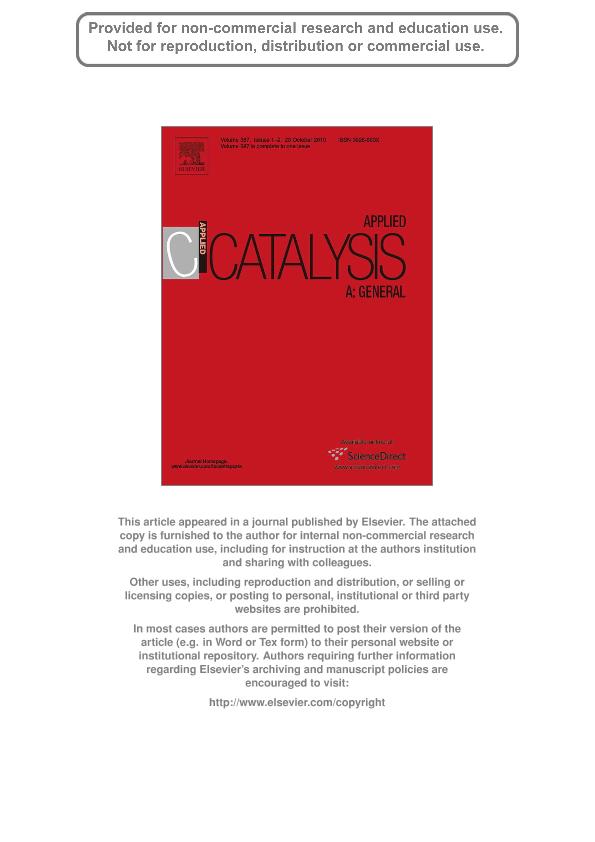Mostrar el registro sencillo del ítem
dc.contributor.author
Busto, Mariana

dc.contributor.author
Grau, Javier Mario

dc.contributor.author
Vera, Carlos Roman

dc.date.available
2018-08-03T00:11:36Z
dc.date.issued
2010-10
dc.identifier.citation
Busto, Mariana; Grau, Javier Mario; Vera, Carlos Roman; Screening of optimal pretreatment and reaction conditions for the isomerization-cracking of long paraffins over Pt/WO3–ZrO2 catalysts; Elsevier Science; Applied Catalysis A: General; 387; 1-2; 10-2010; 35-44
dc.identifier.issn
0926-860X
dc.identifier.uri
http://hdl.handle.net/11336/54031
dc.description.abstract
Pretreatment and reaction conditions for the isomerization-cracking of long paraffins over commercial Pt/WO3-ZrO2 catalysts were screened. Optimal conditions were seeked for the production of short, high octane branched paraffins for the gasoline pool. n-C16 was used as a model molecule. The reaction over the acidic catalyst was used to adjust the size of the molecules to the boiling range of gasolines and to add branching in order to increase the octane number of the product. These adjustments had to be done while minimizing the production of light gases and getting a stable activity level. With respect to the pretreatment it was confirmed that the best calcination temperature of the tungstate oxoanion promoted hydroxides was 800 °C. Optimality was mostly related to the activity level. The optimum temperature coincides with the appearance of small WO3 crystallites which are thought to be center for creation of Brönsted acid sites in the presence of platinum and hydrogen. Regarding the reaction conditions, increasing temperature values augmented the conversion but also increased the cracking. Therefore optimum values were found at moderate temperature given the high reactivity of the feed. Space velocity values were analyzed with attention to the liquid C5+ yield, the selectivity to branched isomers and the stability of the catalysts. Best yields to branched naphtha products were obtained with Pt/WO3-ZrO2 at WHSV = 18 h-1. The catalyst coking rate was a function of the H2/hydrocarbon ratio. A value of 6 was enough to attain a stable conversion value on Pt/WO 3-ZrO2. The values of liquid yield as a function of pressure displayed a volcano pattern that was rationalized in terms of a non-classical bifunctional mechanism of reaction. High pressure values increased the concentration of Brönsted acid sites and hence the activity. Too high pressures enhanced hydrocracking and decreased the liquid yield. The results indicate that in general terms Pt/WO3-ZrO2 at moderate reaction conditions transforms a paraffinic heavy cut into a branched isomerizate that can be added to the gasoline pool to improve the quality properties. It was however found that under some conditions the octane gain is inversely proportional to the yield of light gases indicating that a high RON isomerizate can only be got at the expense of the liquid yield.
dc.format
application/pdf
dc.language.iso
eng
dc.publisher
Elsevier Science

dc.rights
info:eu-repo/semantics/openAccess
dc.rights.uri
https://creativecommons.org/licenses/by-nc-sa/2.5/ar/
dc.subject
Cracking
dc.subject
Gasoline
dc.subject
Hexadecane
dc.subject
Isomerization
dc.subject
Reaction Conditions
dc.subject
Tungsten-Zirconia
dc.subject.classification
Otras Ciencias Químicas

dc.subject.classification
Ciencias Químicas

dc.subject.classification
CIENCIAS NATURALES Y EXACTAS

dc.title
Screening of optimal pretreatment and reaction conditions for the isomerization-cracking of long paraffins over Pt/WO3–ZrO2 catalysts
dc.type
info:eu-repo/semantics/article
dc.type
info:ar-repo/semantics/artículo
dc.type
info:eu-repo/semantics/publishedVersion
dc.date.updated
2018-07-31T17:35:49Z
dc.journal.volume
387
dc.journal.number
1-2
dc.journal.pagination
35-44
dc.journal.pais
Países Bajos

dc.journal.ciudad
Amsterdam
dc.description.fil
Fil: Busto, Mariana. Consejo Nacional de Investigaciones Científicas y Técnicas. Centro Científico Tecnológico Conicet - Santa Fe. Instituto de Investigaciones en Catálisis y Petroquímica "Ing. José Miguel Parera". Universidad Nacional del Litoral. Instituto de Investigaciones en Catálisis y Petroquímica "Ing. José Miguel Parera"; Argentina
dc.description.fil
Fil: Grau, Javier Mario. Consejo Nacional de Investigaciones Científicas y Técnicas. Centro Científico Tecnológico Conicet - Santa Fe. Instituto de Investigaciones en Catálisis y Petroquímica "Ing. José Miguel Parera". Universidad Nacional del Litoral. Instituto de Investigaciones en Catálisis y Petroquímica "Ing. José Miguel Parera"; Argentina
dc.description.fil
Fil: Vera, Carlos Roman. Consejo Nacional de Investigaciones Científicas y Técnicas. Centro Científico Tecnológico Conicet - Santa Fe. Instituto de Investigaciones en Catálisis y Petroquímica "Ing. José Miguel Parera". Universidad Nacional del Litoral. Instituto de Investigaciones en Catálisis y Petroquímica "Ing. José Miguel Parera"; Argentina
dc.journal.title
Applied Catalysis A: General

dc.relation.alternativeid
info:eu-repo/semantics/altIdentifier/doi/http://dx.doi.org/10.1016/j.apcata.2010.07.061
Archivos asociados
